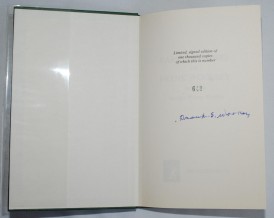Early Memories of Frank Woolley
Martin Chandler |Published: 1976
Pages: 52
Author: Woolley, Martha
Publisher: The Cricketer
Rating: 3.5 stars

The career figures of Frank Woolley are eye watering. In a First Class career that extended from 1906 to 1938 he scored 58,969 runs, a total second only to Jack Hobbs. As if that weren’t enough he also took 2,068 wickets with his orthodox left arm spin and held 1,015 catches, most of them at slip. That latter record is one he still holds, and doubtless will in perpetuity.
Woolley’s name does not resonate today in quite the way that perhaps it should. His contemporaries spoke of him in glowing terms, but although he played as many as 64 times for England his record at that level is relatively modest, and that no doubt is part of the reason for his stock having fallen over the years.
In 1936, at a time when few cricketers did, Woolley published an autobiography, The King of Games. In 1969 Ian Peebles wrote a biography Woolley – The Pride of Kent but, despite Woolley’s pre-eminence no further detailed look at his long life has ever been taken. Most biographies, and indeed autobiographies, contain a chapter or two on their subject’s origin. In Woolley’s case Peebles skipped through his childhood in few sentences, and Woolley himself said little more in The King of Games.
By 1976 Woolley, then 88, was living in Canada with his second wife, Martha, and was persuaded to open up about his early life and this small book is the result. It is a fascinating memoir and one which really does suggest that a fully researched life of Woolley by a twenty first century writer would be a worthwhile exercise, and it is to be hoped that if they have not already done so someone picks up that particular baton very soon.
I know little about the second Mrs Woolley, other than that she was American, and a widow when the pair met, but she was responsible for committing her husband’s memories to writing and the skill with which she does so certainly suggests she was an experienced writer.
However well written a book is however matters little if the content is uninteresting, and one is left wondering just why the details of Woolley’s early life had, effectively, been skipped in the past. His parents’ characters are brought to life, as are his three older brothers. The family came from humble beginnings, but by dint of hard work Woolley’s father build up a garage business that enjoyed considerable success before, by dint of what appears to have been a capricious decision of a local authority made without any compensation being paid to those who were adversely affected, being all but destroyed. It is a story that, perhaps surprisingly, Woolley relates without bitterness.
With age comes experience and wisdom and Woolley, with his wife’s help, is also able to make some interesting comparisons with the world in the mid 1970s, which had many problems, with the troubles that afflicted Victorian England, and an important incidental benefit of the book is the social history it provides, particularly in the final chapter which is an opportunity for Woolley to reflect on a visit to his roots that had taken place shortly before the book was completed.
There is also something of a mystery created by the book, the solving of which would be another sound reason for further research. Woolley’s brother Claud, just a year older, served in France during the Great War and was wounded in Passchendaele by the same explosion that claimed the life of Woolley’s Kent teammate Colin Blythe. In this memoir Woolley writes of Claud that after that he became a pathetic ruin and remained a hopeless invalid throughout life. These are not comments that sit easily with the knowledge that all-rounder Claud was a regular for Northamptonshire for a dozen years after the war, and went on to become a First Class umpire who stood in one Test in the famous 1948 Ashes series.
Early Memories of Frank Woolley was one of a handful of ventures into book publishing that The Cricketer made in the period (the Peebles biography had been another) and appeared in a signed and numbered limited edition. That said there are a thousand copies so the book is certainly not rare and there are always a number of copies available on the second hand market, something which suggests that vendors have somewhat unrealistic expectations of the book’s value. It was not issued with a dust jacket as such, although a copy with the original undamaged glassine wraparound will attract a small premium. It should be possible to pick up a copy for less than £20.







Leave a comment